Leadership and Systems: Reflective Questions Assignment
VerifiedAdded on 2020/03/07
|9
|1878
|62
Homework Assignment
AI Summary
This assignment delves into the interconnectedness of social and technical systems within organizations, using BHP Billiton as a prime example of Corporate Social Responsibility (CSR) implementation through integrated technical systems. It also examines the application of system thinking, with Qantas Airways as a case study, highlighting the challenges and prerequisites for effective implementation, such as departmental collaboration and a unified vision. Furthermore, the assignment explores the impact of Human Resource (HR) interventions on organizational performance, focusing on leadership development programs and performance appraisal interventions, emphasizing their significance in fostering employee trust and driving organizational growth. The student provides detailed insights into the importance of these interventions for enhancing overall effectiveness and achieving strategic goals within a business context.
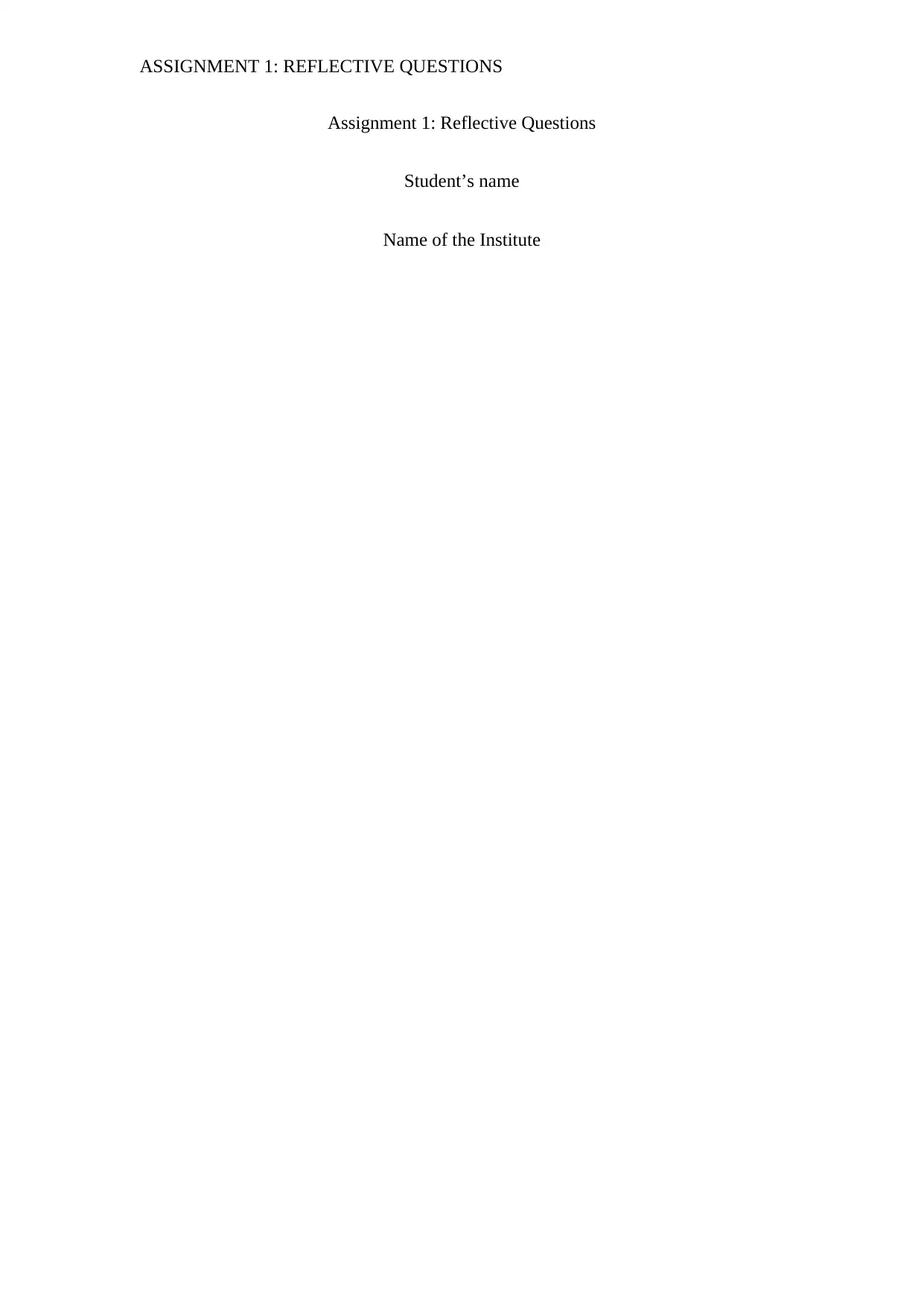
ASSIGNMENT 1: REFLECTIVE QUESTIONS
Assignment 1: Reflective Questions
Student’s name
Name of the Institute
Assignment 1: Reflective Questions
Student’s name
Name of the Institute
Paraphrase This Document
Need a fresh take? Get an instant paraphrase of this document with our AI Paraphraser
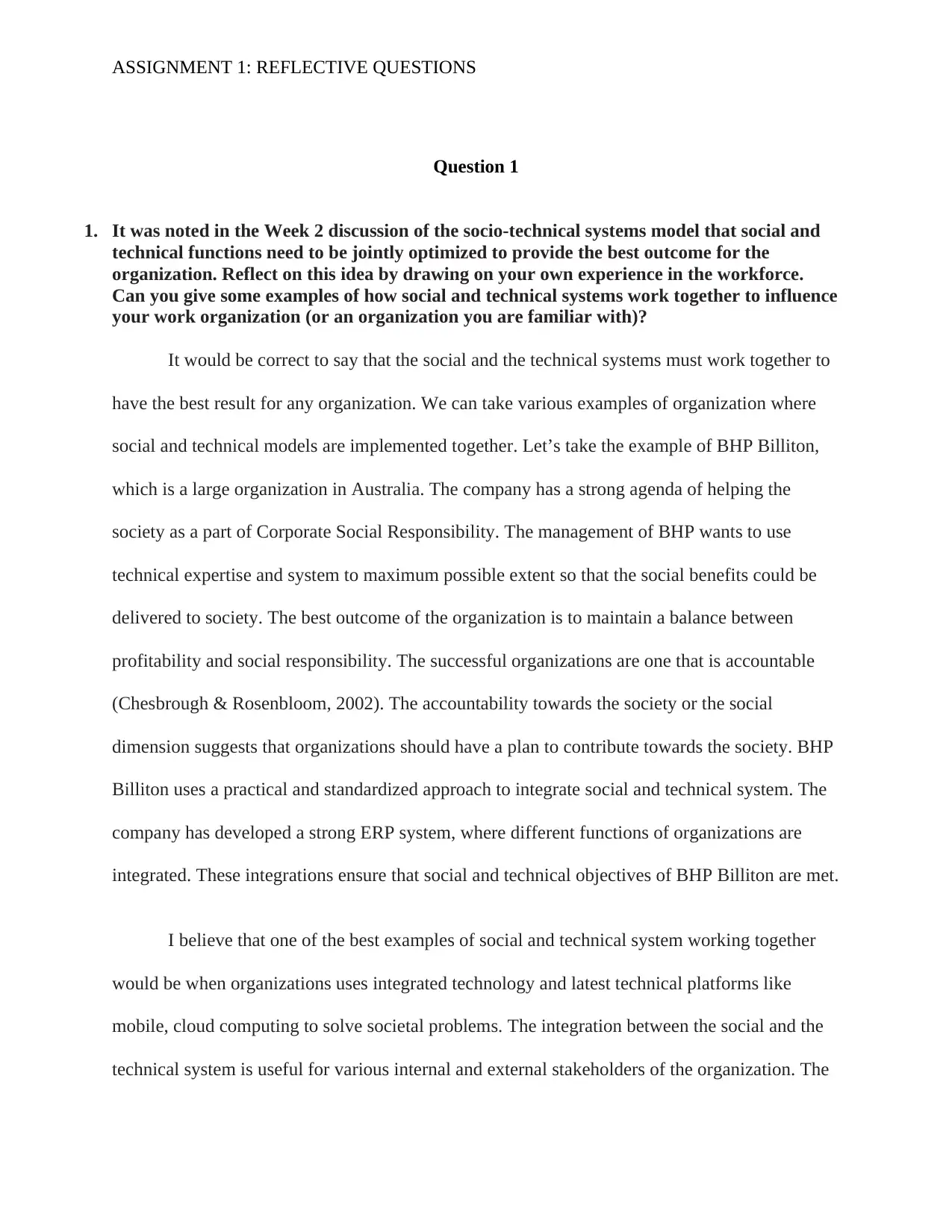
ASSIGNMENT 1: REFLECTIVE QUESTIONS
Question 1
1. It was noted in the Week 2 discussion of the socio-technical systems model that social and
technical functions need to be jointly optimized to provide the best outcome for the
organization. Reflect on this idea by drawing on your own experience in the workforce.
Can you give some examples of how social and technical systems work together to influence
your work organization (or an organization you are familiar with)?
It would be correct to say that the social and the technical systems must work together to
have the best result for any organization. We can take various examples of organization where
social and technical models are implemented together. Let’s take the example of BHP Billiton,
which is a large organization in Australia. The company has a strong agenda of helping the
society as a part of Corporate Social Responsibility. The management of BHP wants to use
technical expertise and system to maximum possible extent so that the social benefits could be
delivered to society. The best outcome of the organization is to maintain a balance between
profitability and social responsibility. The successful organizations are one that is accountable
(Chesbrough & Rosenbloom, 2002). The accountability towards the society or the social
dimension suggests that organizations should have a plan to contribute towards the society. BHP
Billiton uses a practical and standardized approach to integrate social and technical system. The
company has developed a strong ERP system, where different functions of organizations are
integrated. These integrations ensure that social and technical objectives of BHP Billiton are met.
I believe that one of the best examples of social and technical system working together
would be when organizations uses integrated technology and latest technical platforms like
mobile, cloud computing to solve societal problems. The integration between the social and the
technical system is useful for various internal and external stakeholders of the organization. The
Question 1
1. It was noted in the Week 2 discussion of the socio-technical systems model that social and
technical functions need to be jointly optimized to provide the best outcome for the
organization. Reflect on this idea by drawing on your own experience in the workforce.
Can you give some examples of how social and technical systems work together to influence
your work organization (or an organization you are familiar with)?
It would be correct to say that the social and the technical systems must work together to
have the best result for any organization. We can take various examples of organization where
social and technical models are implemented together. Let’s take the example of BHP Billiton,
which is a large organization in Australia. The company has a strong agenda of helping the
society as a part of Corporate Social Responsibility. The management of BHP wants to use
technical expertise and system to maximum possible extent so that the social benefits could be
delivered to society. The best outcome of the organization is to maintain a balance between
profitability and social responsibility. The successful organizations are one that is accountable
(Chesbrough & Rosenbloom, 2002). The accountability towards the society or the social
dimension suggests that organizations should have a plan to contribute towards the society. BHP
Billiton uses a practical and standardized approach to integrate social and technical system. The
company has developed a strong ERP system, where different functions of organizations are
integrated. These integrations ensure that social and technical objectives of BHP Billiton are met.
I believe that one of the best examples of social and technical system working together
would be when organizations uses integrated technology and latest technical platforms like
mobile, cloud computing to solve societal problems. The integration between the social and the
technical system is useful for various internal and external stakeholders of the organization. The
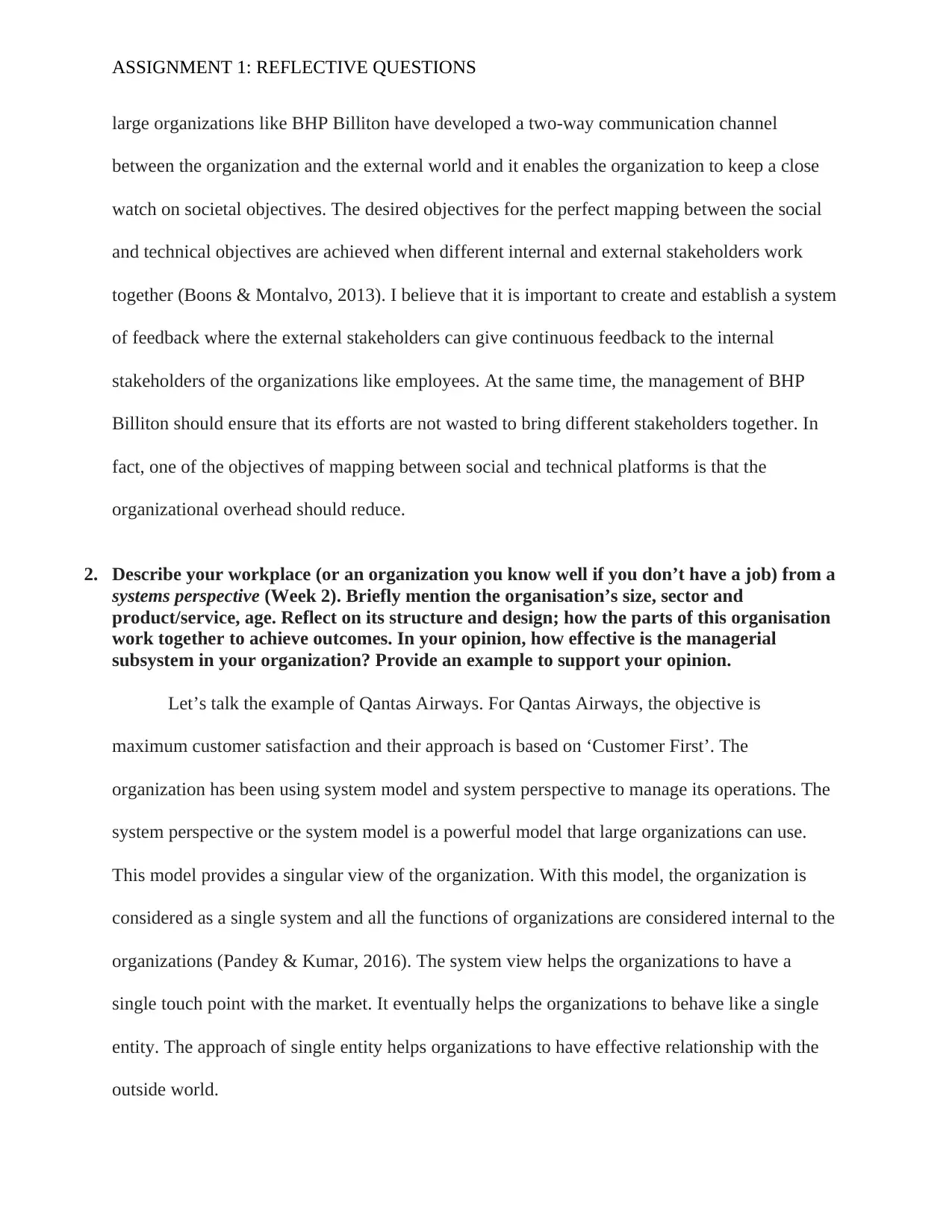
ASSIGNMENT 1: REFLECTIVE QUESTIONS
large organizations like BHP Billiton have developed a two-way communication channel
between the organization and the external world and it enables the organization to keep a close
watch on societal objectives. The desired objectives for the perfect mapping between the social
and technical objectives are achieved when different internal and external stakeholders work
together (Boons & Montalvo, 2013). I believe that it is important to create and establish a system
of feedback where the external stakeholders can give continuous feedback to the internal
stakeholders of the organizations like employees. At the same time, the management of BHP
Billiton should ensure that its efforts are not wasted to bring different stakeholders together. In
fact, one of the objectives of mapping between social and technical platforms is that the
organizational overhead should reduce.
2. Describe your workplace (or an organization you know well if you don’t have a job) from a
systems perspective (Week 2). Briefly mention the organisation’s size, sector and
product/service, age. Reflect on its structure and design; how the parts of this organisation
work together to achieve outcomes. In your opinion, how effective is the managerial
subsystem in your organization? Provide an example to support your opinion.
Let’s talk the example of Qantas Airways. For Qantas Airways, the objective is
maximum customer satisfaction and their approach is based on ‘Customer First’. The
organization has been using system model and system perspective to manage its operations. The
system perspective or the system model is a powerful model that large organizations can use.
This model provides a singular view of the organization. With this model, the organization is
considered as a single system and all the functions of organizations are considered internal to the
organizations (Pandey & Kumar, 2016). The system view helps the organizations to have a
single touch point with the market. It eventually helps the organizations to behave like a single
entity. The approach of single entity helps organizations to have effective relationship with the
outside world.
large organizations like BHP Billiton have developed a two-way communication channel
between the organization and the external world and it enables the organization to keep a close
watch on societal objectives. The desired objectives for the perfect mapping between the social
and technical objectives are achieved when different internal and external stakeholders work
together (Boons & Montalvo, 2013). I believe that it is important to create and establish a system
of feedback where the external stakeholders can give continuous feedback to the internal
stakeholders of the organizations like employees. At the same time, the management of BHP
Billiton should ensure that its efforts are not wasted to bring different stakeholders together. In
fact, one of the objectives of mapping between social and technical platforms is that the
organizational overhead should reduce.
2. Describe your workplace (or an organization you know well if you don’t have a job) from a
systems perspective (Week 2). Briefly mention the organisation’s size, sector and
product/service, age. Reflect on its structure and design; how the parts of this organisation
work together to achieve outcomes. In your opinion, how effective is the managerial
subsystem in your organization? Provide an example to support your opinion.
Let’s talk the example of Qantas Airways. For Qantas Airways, the objective is
maximum customer satisfaction and their approach is based on ‘Customer First’. The
organization has been using system model and system perspective to manage its operations. The
system perspective or the system model is a powerful model that large organizations can use.
This model provides a singular view of the organization. With this model, the organization is
considered as a single system and all the functions of organizations are considered internal to the
organizations (Pandey & Kumar, 2016). The system view helps the organizations to have a
single touch point with the market. It eventually helps the organizations to behave like a single
entity. The approach of single entity helps organizations to have effective relationship with the
outside world.
⊘ This is a preview!⊘
Do you want full access?
Subscribe today to unlock all pages.

Trusted by 1+ million students worldwide

ASSIGNMENT 1: REFLECTIVE QUESTIONS
I believe that it is never easy to implement the system thinking approach. There are
various challenges to implement the system thinking approach. I can say that Qantas Airways is
one such organization that has been able to implement the system thinking effectively. However,
it does not mean that all the organizations would be able to master the art of critical thinking.
One of the basic requirements or prerequisite of critical thinking is that different departments of
the organization should work together (Bas, 2014). The organization may not be able to master
the art of system thinking if it is not able to take entire organization as a single system. In the
classical terms, organization as a single system means that the entire organization should have a
common vision and common set of objectives and all the employees of the organization should
have a common vision to achieve that objective. It is also important to mention that it take time
for organizations to implement the system thinking approach. For the implementation purpose,
organizations should start with an assessment phase where the organizations’ readiness about the
system thinking is judged (Martinuzzi & Sedlacko, 2016). Once the assessment is done the next
phase should be framework development phase in which a framework should be developed to
bring the system thinking in the organization. While implementing the system thinking approach,
it is important that organizations must have a long-term plan in place.
3. Reflect on Human Resource interventions (Week 5) as a means of organizational
improvement and complete 1 of the questions below:
a. Have you ever participated in any HR interventions designed to build
interpersonal skills, such as team-building? How was it carried out? How
effective was it?
b. If you have not been involved in any such interventions, choose 2 HR
interventions discussed in the lecture pod that you think have the greatest
I believe that it is never easy to implement the system thinking approach. There are
various challenges to implement the system thinking approach. I can say that Qantas Airways is
one such organization that has been able to implement the system thinking effectively. However,
it does not mean that all the organizations would be able to master the art of critical thinking.
One of the basic requirements or prerequisite of critical thinking is that different departments of
the organization should work together (Bas, 2014). The organization may not be able to master
the art of system thinking if it is not able to take entire organization as a single system. In the
classical terms, organization as a single system means that the entire organization should have a
common vision and common set of objectives and all the employees of the organization should
have a common vision to achieve that objective. It is also important to mention that it take time
for organizations to implement the system thinking approach. For the implementation purpose,
organizations should start with an assessment phase where the organizations’ readiness about the
system thinking is judged (Martinuzzi & Sedlacko, 2016). Once the assessment is done the next
phase should be framework development phase in which a framework should be developed to
bring the system thinking in the organization. While implementing the system thinking approach,
it is important that organizations must have a long-term plan in place.
3. Reflect on Human Resource interventions (Week 5) as a means of organizational
improvement and complete 1 of the questions below:
a. Have you ever participated in any HR interventions designed to build
interpersonal skills, such as team-building? How was it carried out? How
effective was it?
b. If you have not been involved in any such interventions, choose 2 HR
interventions discussed in the lecture pod that you think have the greatest
Paraphrase This Document
Need a fresh take? Get an instant paraphrase of this document with our AI Paraphraser
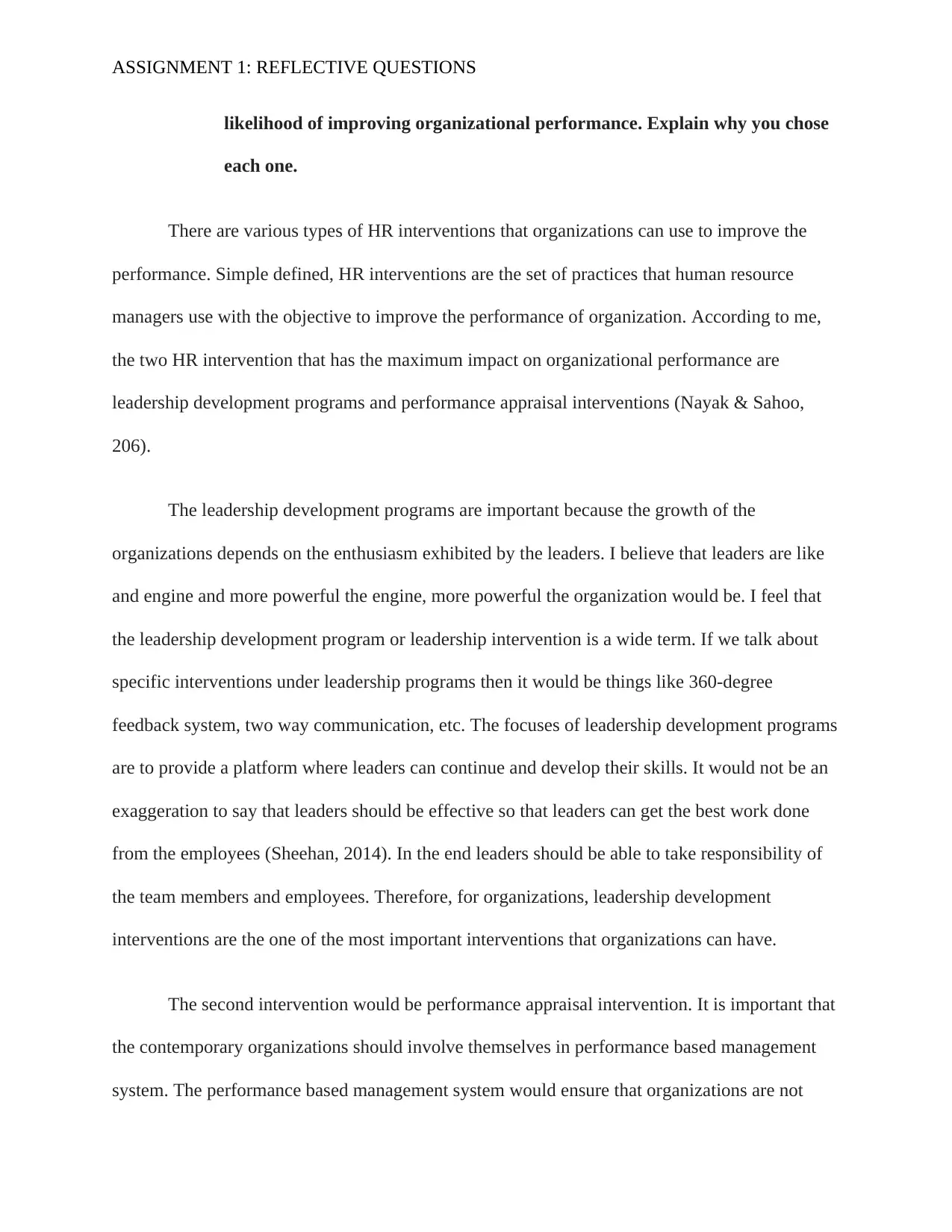
ASSIGNMENT 1: REFLECTIVE QUESTIONS
likelihood of improving organizational performance. Explain why you chose
each one.
There are various types of HR interventions that organizations can use to improve the
performance. Simple defined, HR interventions are the set of practices that human resource
managers use with the objective to improve the performance of organization. According to me,
the two HR intervention that has the maximum impact on organizational performance are
leadership development programs and performance appraisal interventions (Nayak & Sahoo,
206).
The leadership development programs are important because the growth of the
organizations depends on the enthusiasm exhibited by the leaders. I believe that leaders are like
and engine and more powerful the engine, more powerful the organization would be. I feel that
the leadership development program or leadership intervention is a wide term. If we talk about
specific interventions under leadership programs then it would be things like 360-degree
feedback system, two way communication, etc. The focuses of leadership development programs
are to provide a platform where leaders can continue and develop their skills. It would not be an
exaggeration to say that leaders should be effective so that leaders can get the best work done
from the employees (Sheehan, 2014). In the end leaders should be able to take responsibility of
the team members and employees. Therefore, for organizations, leadership development
interventions are the one of the most important interventions that organizations can have.
The second intervention would be performance appraisal intervention. It is important that
the contemporary organizations should involve themselves in performance based management
system. The performance based management system would ensure that organizations are not
likelihood of improving organizational performance. Explain why you chose
each one.
There are various types of HR interventions that organizations can use to improve the
performance. Simple defined, HR interventions are the set of practices that human resource
managers use with the objective to improve the performance of organization. According to me,
the two HR intervention that has the maximum impact on organizational performance are
leadership development programs and performance appraisal interventions (Nayak & Sahoo,
206).
The leadership development programs are important because the growth of the
organizations depends on the enthusiasm exhibited by the leaders. I believe that leaders are like
and engine and more powerful the engine, more powerful the organization would be. I feel that
the leadership development program or leadership intervention is a wide term. If we talk about
specific interventions under leadership programs then it would be things like 360-degree
feedback system, two way communication, etc. The focuses of leadership development programs
are to provide a platform where leaders can continue and develop their skills. It would not be an
exaggeration to say that leaders should be effective so that leaders can get the best work done
from the employees (Sheehan, 2014). In the end leaders should be able to take responsibility of
the team members and employees. Therefore, for organizations, leadership development
interventions are the one of the most important interventions that organizations can have.
The second intervention would be performance appraisal intervention. It is important that
the contemporary organizations should involve themselves in performance based management
system. The performance based management system would ensure that organizations are not
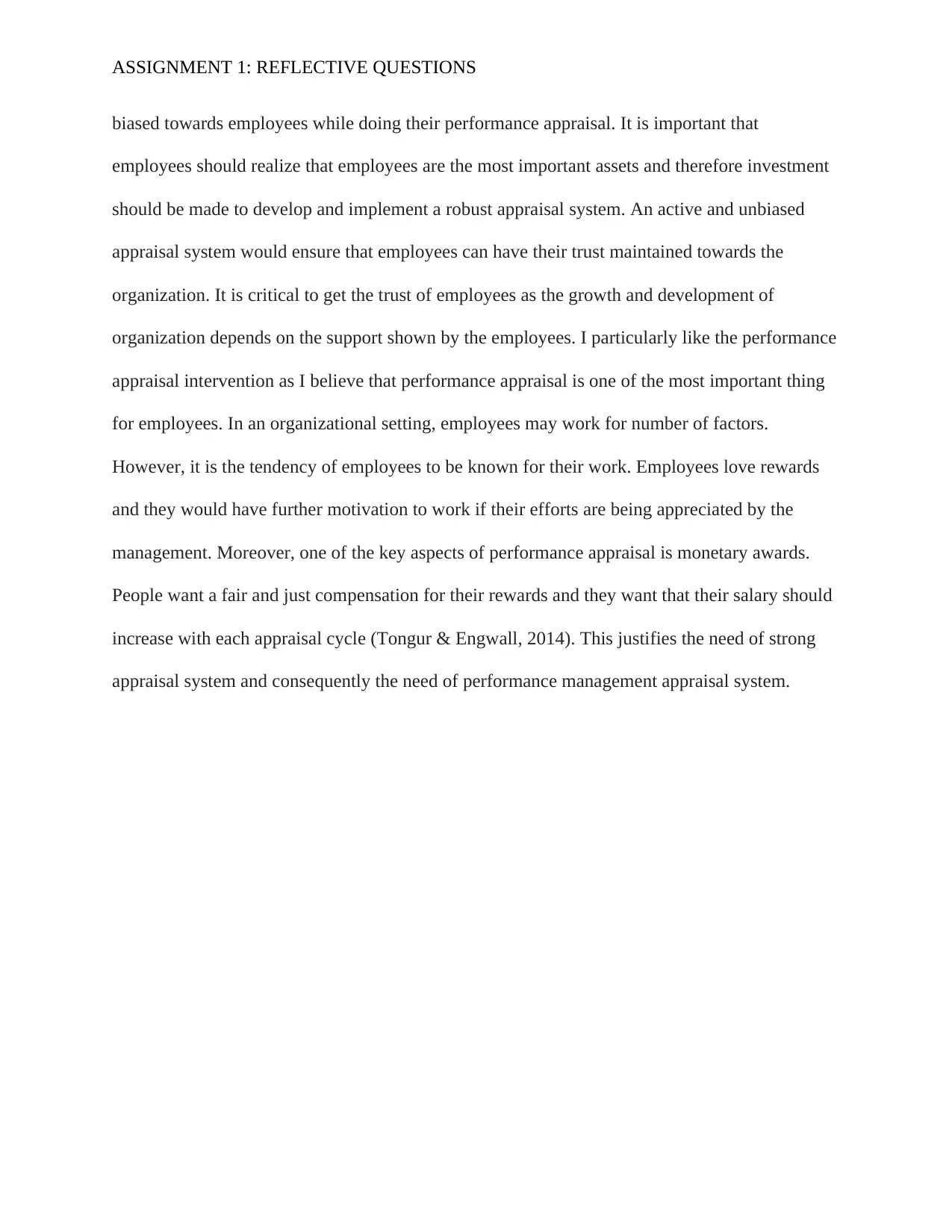
ASSIGNMENT 1: REFLECTIVE QUESTIONS
biased towards employees while doing their performance appraisal. It is important that
employees should realize that employees are the most important assets and therefore investment
should be made to develop and implement a robust appraisal system. An active and unbiased
appraisal system would ensure that employees can have their trust maintained towards the
organization. It is critical to get the trust of employees as the growth and development of
organization depends on the support shown by the employees. I particularly like the performance
appraisal intervention as I believe that performance appraisal is one of the most important thing
for employees. In an organizational setting, employees may work for number of factors.
However, it is the tendency of employees to be known for their work. Employees love rewards
and they would have further motivation to work if their efforts are being appreciated by the
management. Moreover, one of the key aspects of performance appraisal is monetary awards.
People want a fair and just compensation for their rewards and they want that their salary should
increase with each appraisal cycle (Tongur & Engwall, 2014). This justifies the need of strong
appraisal system and consequently the need of performance management appraisal system.
biased towards employees while doing their performance appraisal. It is important that
employees should realize that employees are the most important assets and therefore investment
should be made to develop and implement a robust appraisal system. An active and unbiased
appraisal system would ensure that employees can have their trust maintained towards the
organization. It is critical to get the trust of employees as the growth and development of
organization depends on the support shown by the employees. I particularly like the performance
appraisal intervention as I believe that performance appraisal is one of the most important thing
for employees. In an organizational setting, employees may work for number of factors.
However, it is the tendency of employees to be known for their work. Employees love rewards
and they would have further motivation to work if their efforts are being appreciated by the
management. Moreover, one of the key aspects of performance appraisal is monetary awards.
People want a fair and just compensation for their rewards and they want that their salary should
increase with each appraisal cycle (Tongur & Engwall, 2014). This justifies the need of strong
appraisal system and consequently the need of performance management appraisal system.
⊘ This is a preview!⊘
Do you want full access?
Subscribe today to unlock all pages.

Trusted by 1+ million students worldwide
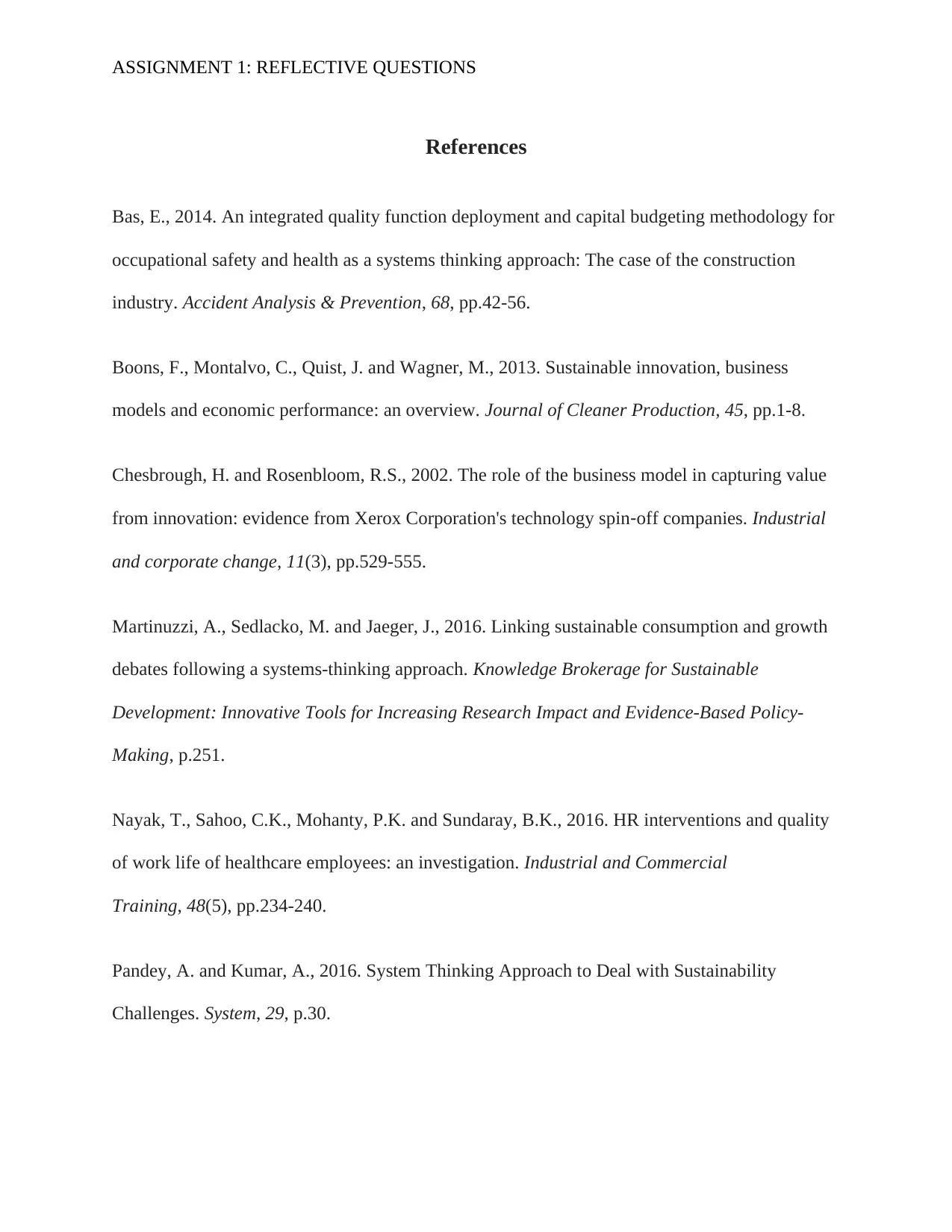
ASSIGNMENT 1: REFLECTIVE QUESTIONS
References
Bas, E., 2014. An integrated quality function deployment and capital budgeting methodology for
occupational safety and health as a systems thinking approach: The case of the construction
industry. Accident Analysis & Prevention, 68, pp.42-56.
Boons, F., Montalvo, C., Quist, J. and Wagner, M., 2013. Sustainable innovation, business
models and economic performance: an overview. Journal of Cleaner Production, 45, pp.1-8.
Chesbrough, H. and Rosenbloom, R.S., 2002. The role of the business model in capturing value
from innovation: evidence from Xerox Corporation's technology spin‐off companies. Industrial
and corporate change, 11(3), pp.529-555.
Martinuzzi, A., Sedlacko, M. and Jaeger, J., 2016. Linking sustainable consumption and growth
debates following a systems-thinking approach. Knowledge Brokerage for Sustainable
Development: Innovative Tools for Increasing Research Impact and Evidence-Based Policy-
Making, p.251.
Nayak, T., Sahoo, C.K., Mohanty, P.K. and Sundaray, B.K., 2016. HR interventions and quality
of work life of healthcare employees: an investigation. Industrial and Commercial
Training, 48(5), pp.234-240.
Pandey, A. and Kumar, A., 2016. System Thinking Approach to Deal with Sustainability
Challenges. System, 29, p.30.
References
Bas, E., 2014. An integrated quality function deployment and capital budgeting methodology for
occupational safety and health as a systems thinking approach: The case of the construction
industry. Accident Analysis & Prevention, 68, pp.42-56.
Boons, F., Montalvo, C., Quist, J. and Wagner, M., 2013. Sustainable innovation, business
models and economic performance: an overview. Journal of Cleaner Production, 45, pp.1-8.
Chesbrough, H. and Rosenbloom, R.S., 2002. The role of the business model in capturing value
from innovation: evidence from Xerox Corporation's technology spin‐off companies. Industrial
and corporate change, 11(3), pp.529-555.
Martinuzzi, A., Sedlacko, M. and Jaeger, J., 2016. Linking sustainable consumption and growth
debates following a systems-thinking approach. Knowledge Brokerage for Sustainable
Development: Innovative Tools for Increasing Research Impact and Evidence-Based Policy-
Making, p.251.
Nayak, T., Sahoo, C.K., Mohanty, P.K. and Sundaray, B.K., 2016. HR interventions and quality
of work life of healthcare employees: an investigation. Industrial and Commercial
Training, 48(5), pp.234-240.
Pandey, A. and Kumar, A., 2016. System Thinking Approach to Deal with Sustainability
Challenges. System, 29, p.30.
Paraphrase This Document
Need a fresh take? Get an instant paraphrase of this document with our AI Paraphraser
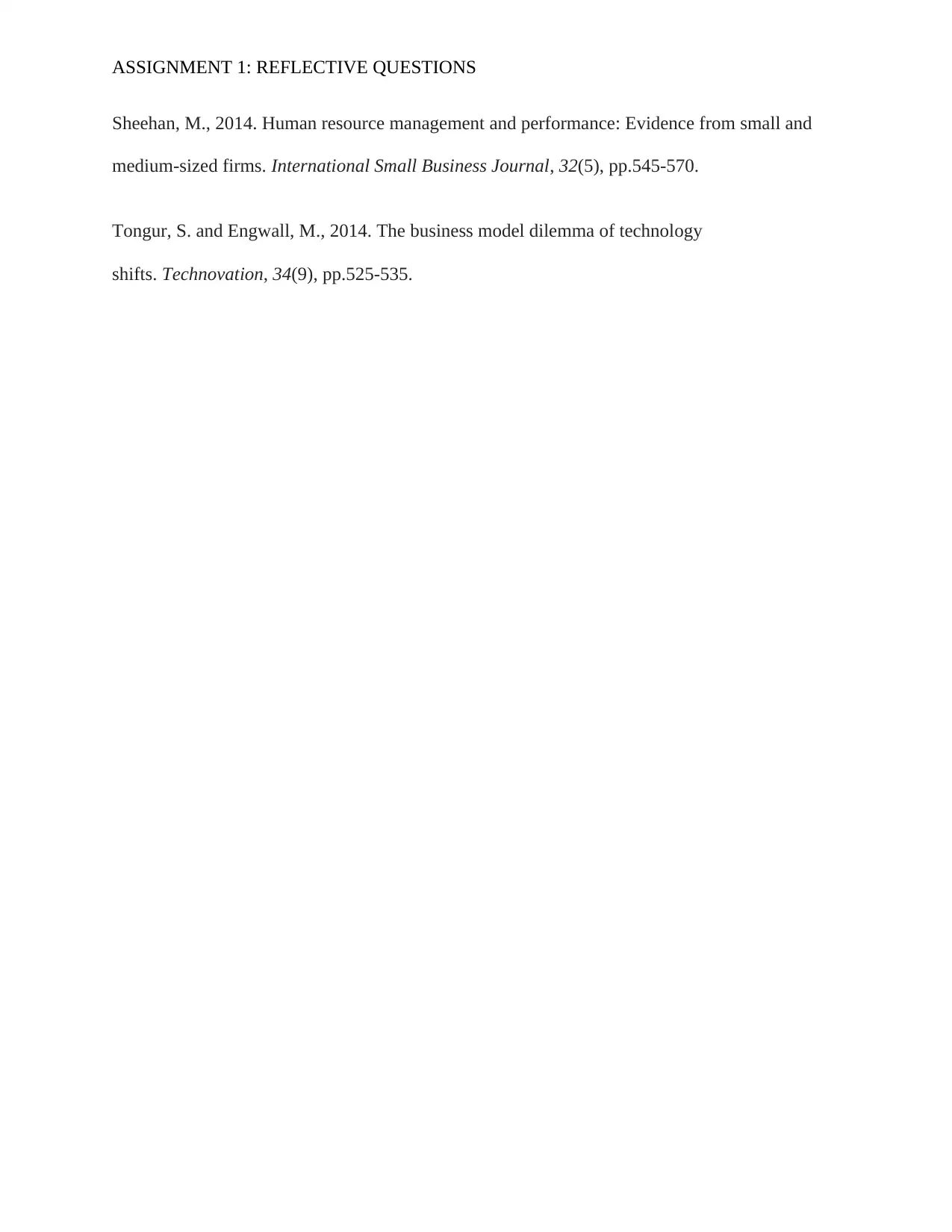
ASSIGNMENT 1: REFLECTIVE QUESTIONS
Sheehan, M., 2014. Human resource management and performance: Evidence from small and
medium-sized firms. International Small Business Journal, 32(5), pp.545-570.
Tongur, S. and Engwall, M., 2014. The business model dilemma of technology
shifts. Technovation, 34(9), pp.525-535.
Sheehan, M., 2014. Human resource management and performance: Evidence from small and
medium-sized firms. International Small Business Journal, 32(5), pp.545-570.
Tongur, S. and Engwall, M., 2014. The business model dilemma of technology
shifts. Technovation, 34(9), pp.525-535.
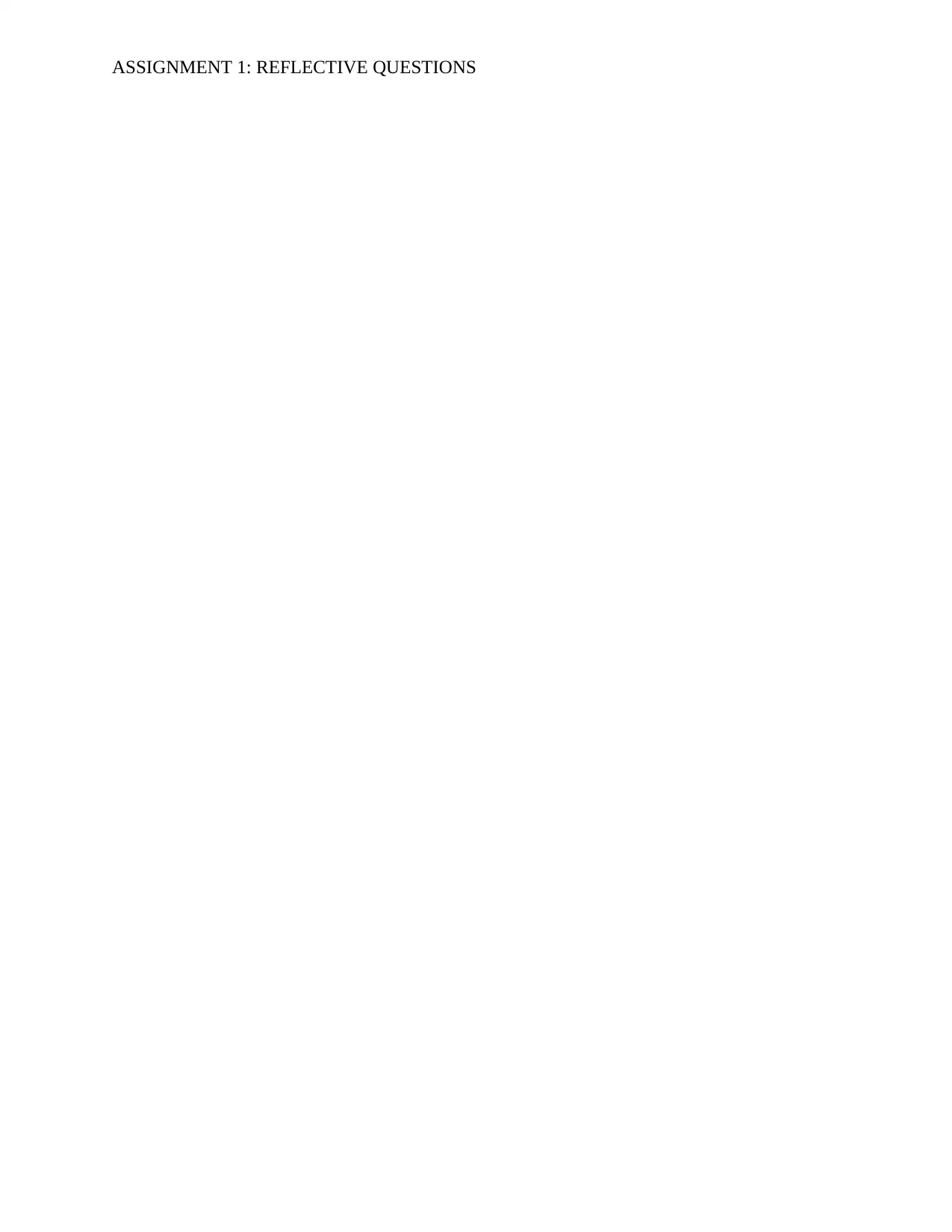
ASSIGNMENT 1: REFLECTIVE QUESTIONS
⊘ This is a preview!⊘
Do you want full access?
Subscribe today to unlock all pages.

Trusted by 1+ million students worldwide
1 out of 9
Related Documents
Your All-in-One AI-Powered Toolkit for Academic Success.
+13062052269
info@desklib.com
Available 24*7 on WhatsApp / Email
![[object Object]](/_next/static/media/star-bottom.7253800d.svg)
Unlock your academic potential
Copyright © 2020–2025 A2Z Services. All Rights Reserved. Developed and managed by ZUCOL.





